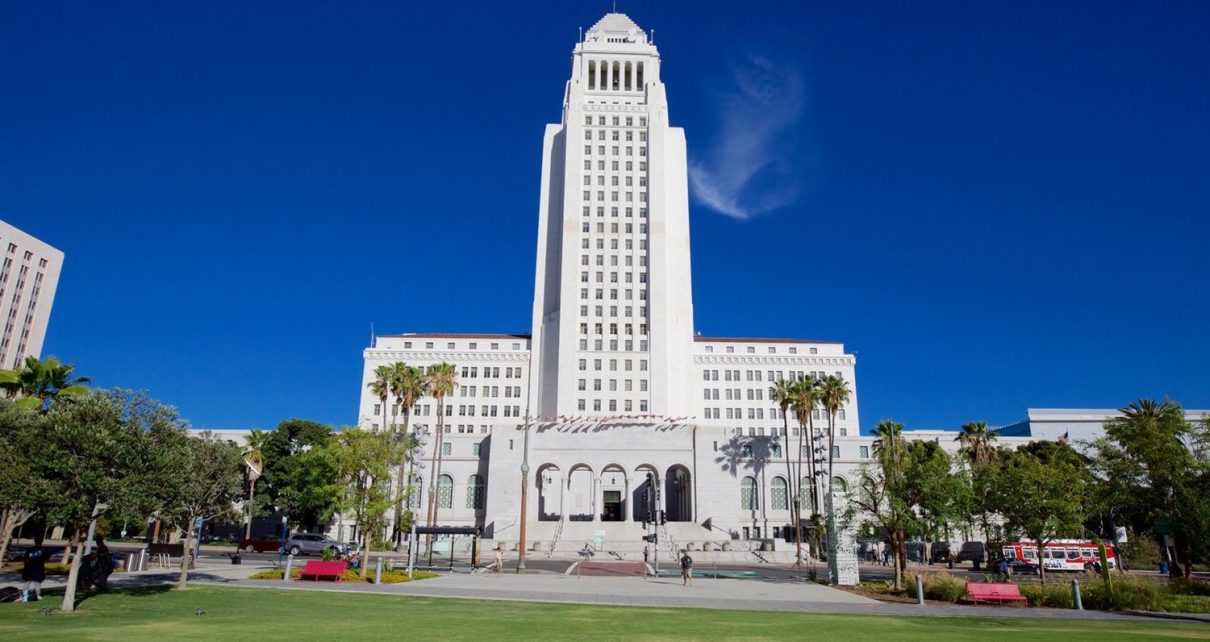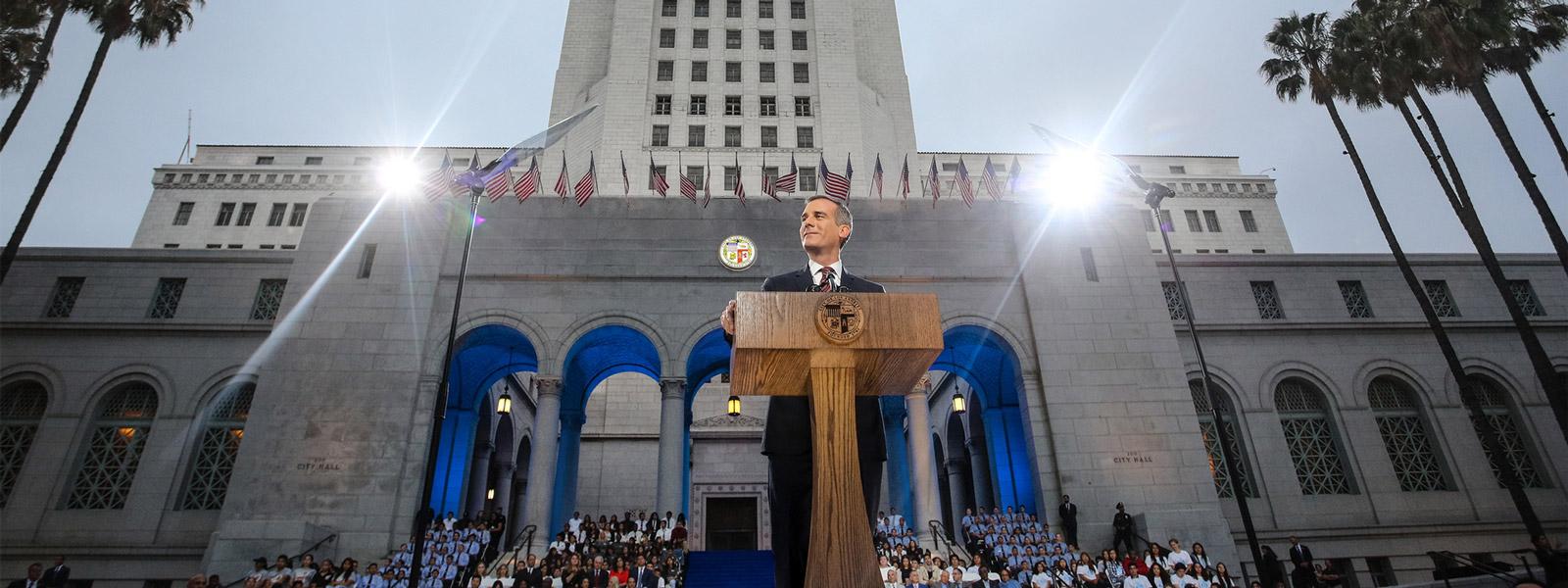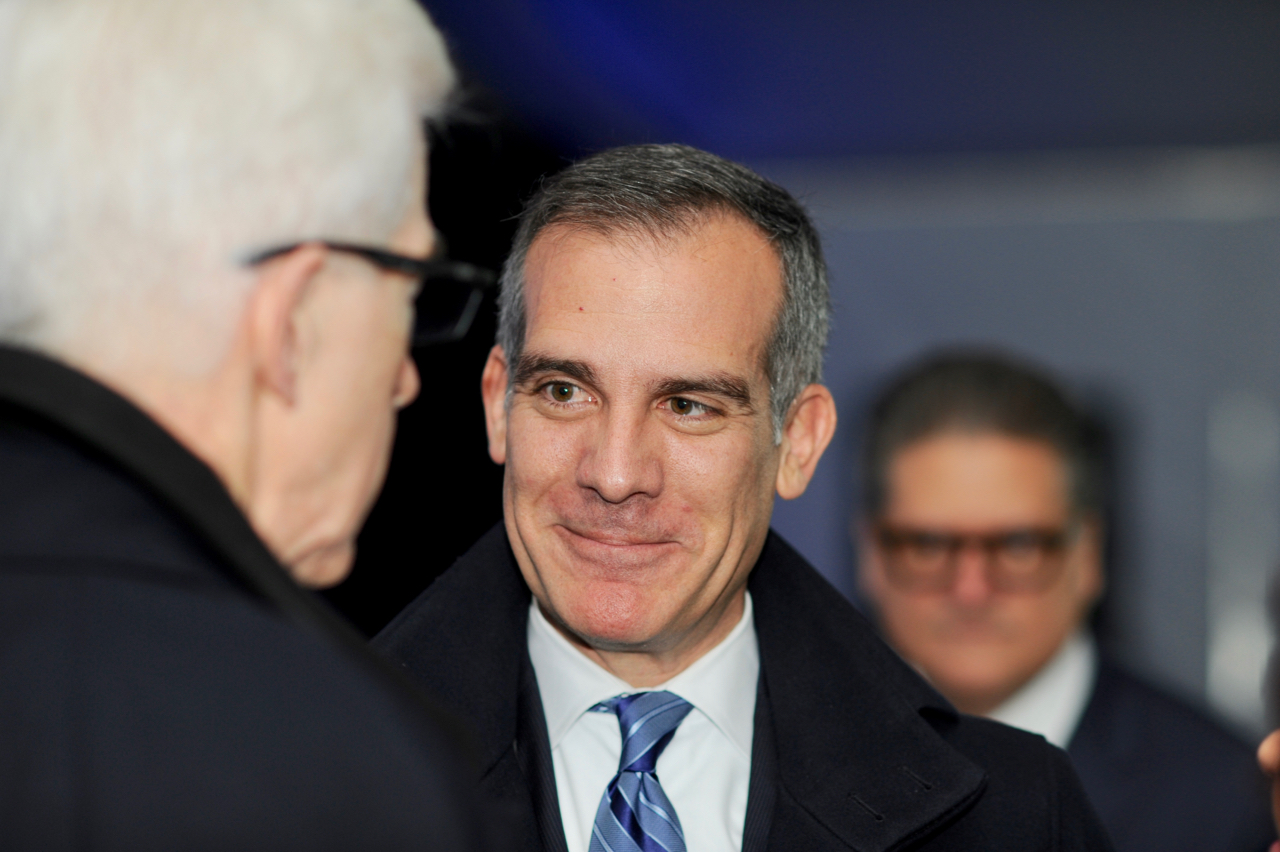
Los Angeles City Hall. (Photo: City of Los Angeles)
Ringside: Rehydrating the Los Angeles Heat Island
Our population has increased by 50 percent since 1985, but our cities are using the same amount of water
By Edward Ring, February 21, 2025 7:00 am
 Along with the fairly recent popularization of terms such as atmospheric river and bomb cyclone, we increasingly hear the term “vapor pressure deficit” (VPD). At any given temperature, the term refers to how much moisture is in the air compared to how much moisture could be in the air. The higher the deficit, the dryer the air.
Along with the fairly recent popularization of terms such as atmospheric river and bomb cyclone, we increasingly hear the term “vapor pressure deficit” (VPD). At any given temperature, the term refers to how much moisture is in the air compared to how much moisture could be in the air. The higher the deficit, the dryer the air.
A recent article in Cal Matters describes how a high vapor pressure deficit in Los Angeles caused winds to have greater drying power, removing moisture from living plants, making fires “almost unstoppable once they start.”
The article goes on to cite a UCLA paper from 2021 that claims that “compared to the 1980s and 1990s, the number of days with an extreme vapor pressure deficit nearly doubled in the first two decades of this century.”
For everyone who wants fires to stop immolating cities, whether they believe the cause is primarily climate change or land mismanagement, adaptation is an urgent priority. The debate is over how to adapt. Everyone may also agree that for the foreseeable future, prioritizing EV mandates and subsidizing solar farms will have zero impact on wildfires. But what if decreasing humidity and higher temperatures in Southern California are not mostly the product of increasing CO2 content in the atmosphere, but something else entirely? How would that affect how we should adapt?
The UCLA study, for example, cited multiple causes of severe wildfires, including bark beetles, reduced summer precipitation, vegetation cover, and live fuel moisture content – all of which are the consequences of a century of fire suppression combined with over-regulation and litigation-driven suppression of logging, grazing, burning, and thinning. Overcrowded trees are susceptible to infestations, don’t transpirate, and are bone dry. Did the study adequately prioritize those variables?
Now consider the reasons it gets hot and dry in Los Angeles. According to the US Census Bureau, the Los Angeles-Long Beach-Anaheim urban area has 11.9 million people living within just 1,638 square miles. That’s 7,265 people per square mile. Since the average human at rest generates 100 watts, just the people in Los Angeles, each of them with an internal temperature around 98.6 degrees, are collectively burning 29 gigawatt-hours every day. That’s just the beginning of this regional heat island.
According to the California Energy Commission (CEC), in 2022 (most recent data), Los Angeles and Orange counties consumed 3,393 million therms of natural gas. That equates to 99,421 gigawatt-hours per year, or another 272 gigawatt-hours per day.
Also courtesy of the CEC is a report on electricity consumption in Los Angeles and Orange counties; another 243 gigawatt-hours per day. And then there’s gasoline, diesel fuel, and aviation fuel. That’s a bit harder to get a fix on, but to make a reasonable estimate let’s assume that the Los Angeles-Long Beach-Anaheim urban area consumes petroleum at the same rate as everyone else in California. That’s probably conservative, since petroleum is not only consumed in the Los Angeles area, but also refined along the coast, but here goes:
According to the US Energy Information Administration, 3,628 trillion BTUs of petroleum products were consumed by Californians in 2022. Based on the 11.9 million population in the Los Angeles-Long Beach-Anaheim urban area — representing 30.4 percent of California’s total population at that time — daily petroleum consumption in the region equates to 798 gigawatt-hours when converted from TBTUs to gigawatt-hours (GWh). By normalizing all these sources of energy to gigawatt-hours, it is easy to see how central petroleum is to our total energy consumption.
Altogether, people, natural gas, electricity, and gasoline and other petroleum fuels burn across the region to the tune of 1,342 gigawatt-hours per day. Where there’s power, there’s heat, and that’s a lot of power. 1,342 GWh equals 4.6 trillion BTUs. If only half of this energy is wasted in the form of heat, at 0.02 BTUs to heat one cubic foot of air by one degree Fahrenheit, we’ve got enough energy to heat 11.4 trillion cubic feet by ten degrees. A blanket of air ten feet thick, covering the entire 1,638 square miles of the Los Angeles region, only has a volume of 456 billion cubic feet. Please poke holes in that math. And thank goodness for the offshore breeze and open sky.
And what about the pavement, buildings, and artificial turf? How much solar energy does that absorb and radiate into the local climate in the form of heat? In a recent column I made the apparently intemperate calculation that the amount of water required to irrigate lawn and trees could be desalinated at an energy cost in rough parity to the amount of energy all those trees and lawns would save by requiring less air conditioning. “Haven’t you heard of Xeriscape?!,” screamed one email. But it’s true.
Imagine Los Angeles before it was Los Angeles. An arcadian paradise, an alluvion wonderland that routinely flooded every time a storm hit the San Gabriels and dumped millions of acre feet of water into the streams and out to the sea. Of course it’s hotter today. A lot hotter. We built a megacity on top of that.
So maybe it’s mostly the heat island that dries out the air in the Los Angeles region, along with the fact that fire suppressed, overgrown hillsides have left too many roots competing for the same amount of water, leading to lower “live fuel moisture.”
The original California Water Plan (here’s part one and part two), written in 1957, called for 50 million acre feet (MAF) of deliverable water per year, with most of it, 40 MAF, for farms. That would have left 10 MAF per year for urban areas, but our cities currently get by on 7.5 MAF per year, the same amount they got in 1985. Our population has increased by 50 percent since 1985, but our cities are using the same amount of water. Without reducing allocations to farmers, why not increase it to 10 MAF per year, so we can plant more trees and more lawns, and revitalize the Los Angeles River? It can be done.
A water agency executive once told me they were trying to get some UC researchers to evaluate the heat island impact on climate in the Los Angeles region. Despite repeated requests, nobody even called them back. That’s too bad. We might learn that logging, grazing, burning, and thinning, along with rehydrating our cities with more water, would lower the temperature and the vapor pressure deficit. It’s worth considering.
- Ringside: EVs and California’s Future Demand for Electricity - December 4, 2025
- Ringside: Politically Viable Water Supply Projects - November 27, 2025
- Ringside: Shifting Costs Does Not Solve California’s Electricity Shortages - November 20, 2025





Democrats claim to worship green yet all they do is produce brown and black. Their real agenda is on display in Pacific Pallisades.
Excellent piece. This sort of thinking is needed if we hope to actually develop solutions to our problem. Reinforces the notion that CA needs more water.
Interested in your observations about the super-high-altitude planes that I see criss-crossing the skies over Southern California on most days early in the morning, creating a sickly white haze that lingers throughout the day…
I used to think those were “just contrails” but after seeing a neatly spaced grid pattern being laid out one weekend while walking the dog early in the day, my thoughts on the matter have changed drastically….
I’d like to read more about the river.